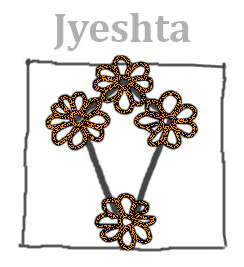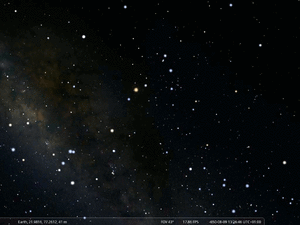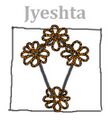Jyeshtha: Difference between revisions
No edit summary |
No edit summary |
||
| (8 intermediate revisions by the same user not shown) | |||
| Line 1: | Line 1: | ||
{{DISPLAYTITLE:}} |
{{DISPLAYTITLE:Jyeṣṭha (ज्येष्ठा)}} |
||
[[File:Jyeshta nakshatras in Temple draw+lbl 4ase.jpg|thumb|Jyeshta, 18th nakshatra, in Tirupperunthurai (Athmanathaswamy temple) near Aranthangi, India, 10th century CE. (SMH 2025).]] |
|||
| ⚫ | |||
[[File:17-19 nakshatra stellarium.gif|thumb|The 17th, 18th, 19th nakshatra mapped to the Stellarium base chart, animated GIF, WGSN 2025: Jyeshtha is the middle one. ]] |
|||
Jyeṣṭha (ज्येष्ठा), The Eldest, is an Indian name, used by the Indian Vedic tradition. Most of these names are roughly 3000 years old. They pre-date Hinduism but were taken over by it. |
|||
==Etymology and History== |
==Etymology and History== |
||
'''Name Variants''' |
|||
What does the term mean, does it always have the same meaning - was it changed over time. |
|||
*Jyeṣṭha, |
|||
*Jyeshtha, |
|||
*Śakra, |
|||
*Aindra |
|||
| ⚫ | |||
| ⚫ | |||
The asterism is depicted as a group of three stars and typically identified with the bright star Antares (α Sco). As the term "nakshatra" literally means "not bright", it is more likely that the stars surrounding Antares, τ and σ Scorpii plus i Sco (or d Sco?), were interpreted as an asterism framing the bright star in the center. |
|||
Jyeshtha is also the name of a goddess. |
|||
| ⚫ | |||
| ⚫ | |||
| ⚫ | |||
mnemonic tales and cultural significance |
|||
| ⚫ | |||
== Weblinks == |
|||
<gallery> |
|||
File:Jyeshta nakshatras in Temple draw+lbl 4ase.jpg|Jyeshta, 18th nakshatra, 10th century CE |
|||
File:Nakshatra temple magDraw lbl.jpg|Display of all 28th nakshatras in silver arch with candles in Tirupperunthurai (Athmanathaswamy temple) near Aranthangi, India, 10th century CE. (SMH 2025). |
|||
File:Nakshatras in Temple draw+lbl 4ase.jpg|Display of all 28th nakshatras in a door frame in Tirupperunthurai (Athmanathaswamy temple) near Aranthangi, India, 10th century CE. (SMH 2025). |
|||
File:Jyeshta Gauri.jpg|Jyeshta Gauri |
|||
File:Jyeshta in East Niche, North wall, Kailasanathar Temple, Kanchipuram.jpg|Jyeshta Goddess |
|||
File:18 Jyeshtha draw.png|Jyeshta as recontructed by Jones (1720). |
|||
</gallery> |
|||
| ⚫ | |||
* {{NAMESPACE}} |
|||
Jyeshta was a favourite Goddess of Pallavas and worshipped as a Fertility Goddess and by some as Sanigraha's wife. She is one among the Parivara deities of Shiva, but with the popularity of Laxmi on the rise the Alaxmi worship had a downfall and she was moved far away from the temple premises. She is now found abandoned near Ponds and Water bodies with no worship. Only some temples have retained her within the premises. |
|||
== |
==Weblinks== |
||
==References== |
|||
*[[References]] (general) |
|||
[[Category:Indian]] |
|||
[[Category:Indian]] [[Category:Asterism]] [[Category:Constellation]][[Category:Eurasia]][[Category:South Asian]] |
|||
[[Category:Asterism]] |
|||
[[Category:Constellation]] |
|||
[[Category:Eurasia]] |
|||
[[Category:South Asian]] |
|||
[[Category:Zodiac]] |
|||
Latest revision as of 16:16, 30 October 2025
Jyeṣṭha (ज्येष्ठा), The Eldest, is an Indian name, used by the Indian Vedic tradition. Most of these names are roughly 3000 years old. They pre-date Hinduism but were taken over by it.
Etymology and History
Name Variants
- Jyeṣṭha,
- Jyeshtha,
- Śakra,
- Aindra
Origin of Constellation
The asterism is depicted as a group of three stars and typically identified with the bright star Antares (α Sco). As the term "nakshatra" literally means "not bright", it is more likely that the stars surrounding Antares, τ and σ Scorpii plus i Sco (or d Sco?), were interpreted as an asterism framing the bright star in the center.
Jyeshtha is also the name of a goddess.
Transfer and Transformation of the Constellation
Mythology
Jyeshta was a favourite Goddess of Pallavas and worshipped as a Fertility Goddess and by some as Sanigraha's wife. She is one among the Parivara deities of Shiva, but with the popularity of Laxmi on the rise the Alaxmi worship had a downfall and she was moved far away from the temple premises. She is now found abandoned near Ponds and Water bodies with no worship. Only some temples have retained her within the premises.
Weblinks
References
- References (general)












